|
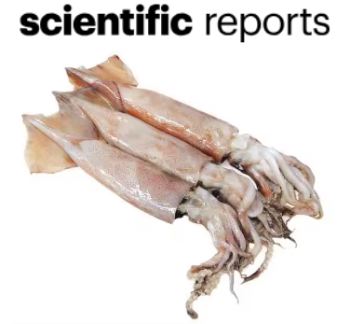
Paiva, B.L., Rodrigues, A.E.S., Almeida, I.O.d. et al. Sci Rep 14, 30007 (2024)
Scientific report: Molecular identification of whole squids and calamari at fairs and markets in regions of Latin America
 BRAZIL
BRAZIL
Wednesday, December 04, 2024, 00:10 (GMT + 9)
Currently, cephalopods represent about 7% of seafood production, their landings have increased since 1961, reaching a record of captured and commercialized tons in 2020. In terms of cephalopods catches and consumption, Asian, European, African and North American countries have the ten largest fishing fleets in the world, with Spain, Italy and Japan being the largest consumers.
In South America, the jumbo flying squid, Dosidicus gigas has been widely explored, being exported by Peru to more than 50 countries, where several attempts are being made to diversify new products made with the species among them, canned, pre-cooked, roasted and others. This high demand for export means that the commercialization of entire species is greatly reduced or made difficult, with the need for processing often resulting in a longer shelf life of derived products.
However, processing most often removes or damages diagnostic features that are important for correct species identification through traditional taxonomic characteristics. In the case of cephalopods, there is the removal of the intestines, skin, arms, tentacles, fins and head, where the species are often cut into rings or tubes, thus removing all morphological characteristics which are used to identify species as sex, or sexual maturity, a process that make all species be commercialized under the umbrella term “calamari”.
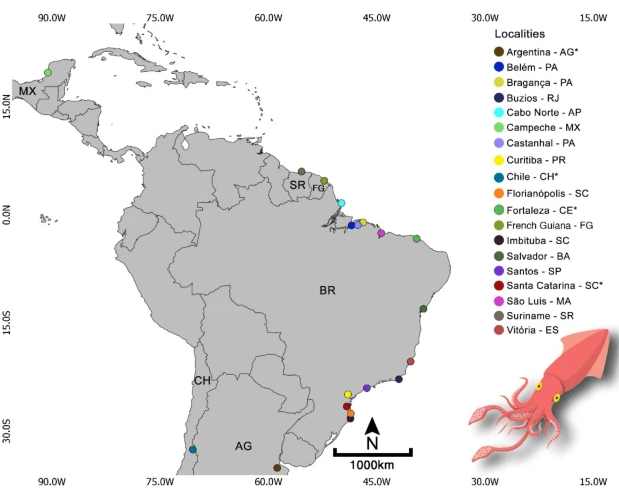
Map showing all squid sampling places utilized in the present study. Colored circles correspond to each locality. Click on the image to enlarge
These modifications make taxonomic identification difficult or even impossible, making it more prone to economic fraud where highly valued species, such as those from the family Loliginidae, are replaced by species of lower commercial value, such as those from the Ommastrephidae, which becomes a concern for the international commercial market, or often, unintentional substitution, where due to lack of systematic knowledge, suppliers themselves are unable to correctly identify the species, assigning them umbrella terms that shelter many different species.
Molecular methods have been widely used, firstly, to identify new species or populations of different species, thus providing a complement to pure systematic studies, with their applicability in the identification of species already consolidated in several different taxonomic groups, especially DNA barcode methods. This technique is based on analyzing the variability of a short nucleotide sequence (~ 650 bp) to assess differences between species. The cytochrome oxidase subunit I (coxI) gene was initially proposed by, this region of the mitogenome includes both primary and conserved sites, as well as a suitable sequence of variation that allows differentiation between species.
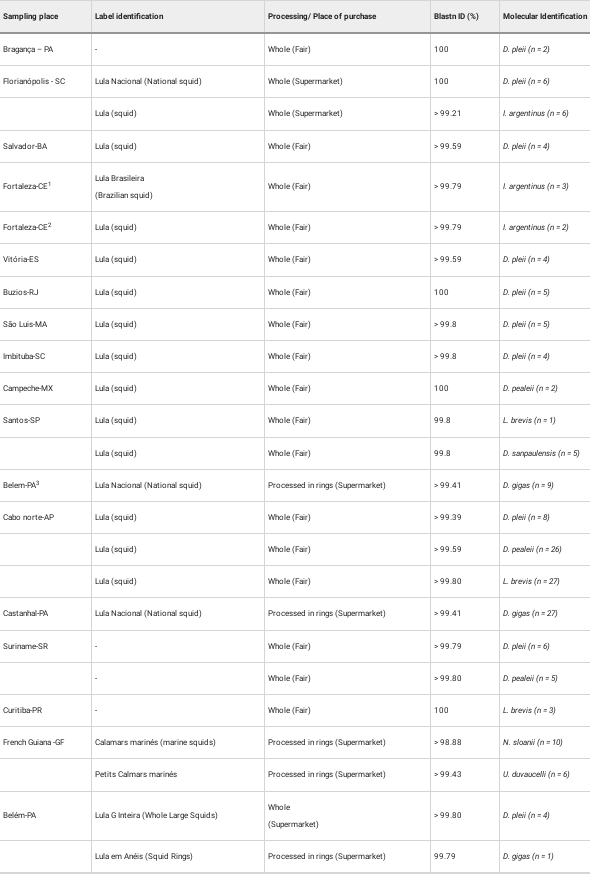
Squid species identified in the present study based on rrnL fragment (16 S rDNA). Click on the image to enlarge
There have been many criticisms regarding the choice of the cox gene as a barcode region, such as the presence of pseudogenes. For mollusk species this is a major problem since several studies have already demonstrated the presence of alterations in the mitochondrial genome, including reorganizations, gene duplications and deletions, in addition to bi-parental inheritance in bivalve species. For cephalopod species, the main limitations of the application of the cox2 gene are found in the Ommastrephidae family due to several species having two copies of this gene making its application as a DNA barcoding tool inappropriate for this group. The large ribosomal region rrnL (also known as 16S rDNA) is another mitochondrial gene present in large copy number in cells and is a suitable alternative to be used as a molecular region for species identification, due to its conserved nature and the fact that, despite the challenges of aligning a non-coding region, is has already been widely used in phylogenetic analysis in cephalopod species, providing a good reference dataset.
Among the main advantages of using molecular methods in the identification of fishery products is the fact that it is easy to amplify target regions, as well as the fact that any portion of the body of a specimen or individuals from preparation processes such as cooking, frying, canning can be used though the degradation of DNA by these processes may mean that longer amplified fragments are less sensitive that shorter fragments. In this way, the applicability of molecular methods can help in the correct identification of the species being commercialized, which can reveal not only economic losses due to substitutions, as well as identify commercialization’s of species that may pose health risks or the presence of endangered species with prohibited capture, fishing and landing status, making it necessary to use appropriate tools to confirm product labeling and avoid commercial fraud. Reliable molecular tools for barcoding DNA analysis have been developed to protect consumers from food frauds and health hazards and to improve the monitoring of endangered species due to overfishing and illegal commercial activities.
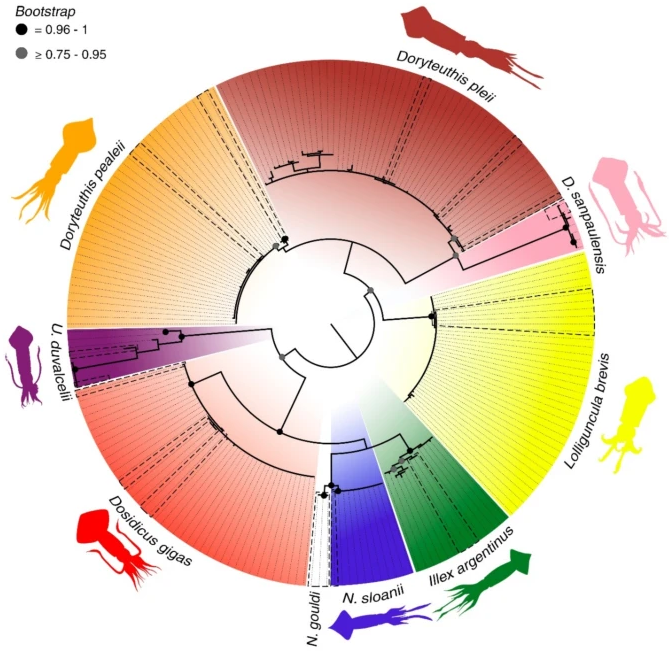
Maximum Likelihood phylogenetic tree showing the phylogenetic placement of the squid samples identified in the present study based on rrnL mitochondrial gene fragment (16 S rDNA). Click on the image to enlarge
When complemented by molecular methods, market research can provide accurate species identification, even for products that have been through the finning and processing before sale58. DNA methods have been widely used for forensic analysis of food products because they provide an efficient, informative, sensitive and specific identification stimulus and because they can be applied to highly processed food products.
In Brazil, legislation on the cephalopod trade does not require all products to bear the common name and scientific name of the species marketed on their labels. This lack in the legislation can lead to the intentional substitution of fish-based products, which can cause economic loss to consumers. The European Union, in an attempt to seek solutions to reduce commercial fraud, has instituted regulations (EC 104/200; EC 2065/2001) that require member countries to make official lists available with scientific, common and commercial names of fish species that are being marketed, as well as requiring that product labels also be clearly informed.
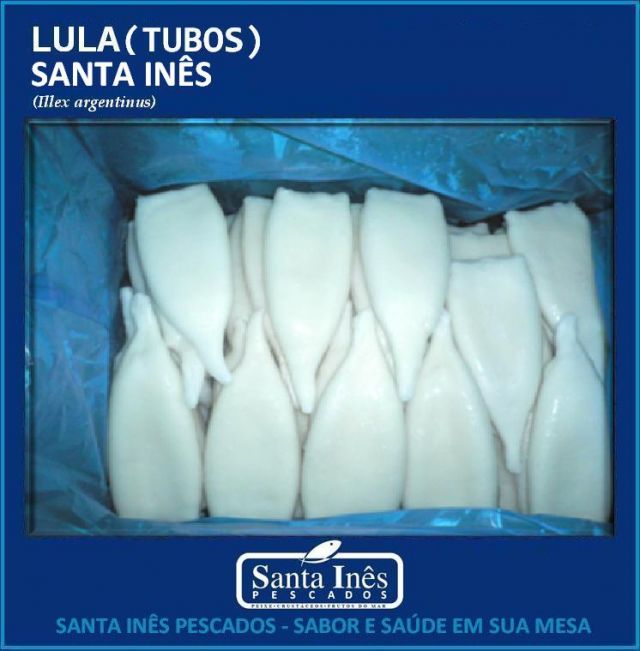
Taking into account all the problems exposed regarding the commercialization of cephalopods, as well as the absence of official legislation labeling these products that are sold in Brazil. The present study aimed to use the fragment of the rrnL to identify which species of squid are being sold, both in the form of trays containing processed animals, and specimens sold whole in markets and fish fairs in some Latin American countries investigating whether there is evidence of intentional substitutions in the trade of cephalopod species.
This research investigates the identification of squid species sold in Latin American markets.
Here are the key points:
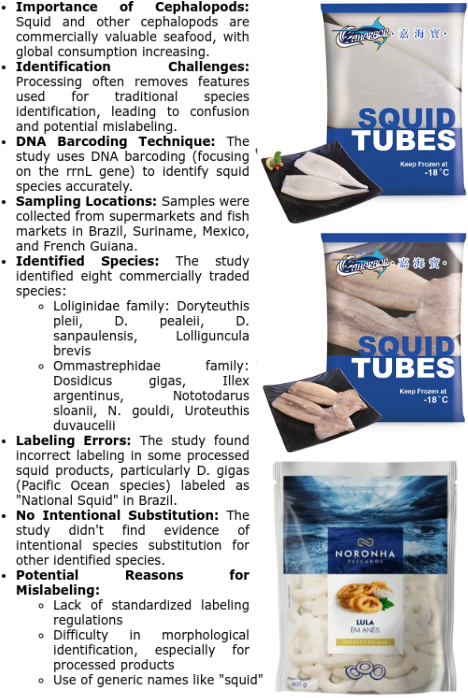

Conclusion:
The study highlights the need for accurate species identification in the cephalopod trade. Molecular tools like DNA barcoding provide a reliable method for this purpose. Implementing standardized labeling regulations can also help prevent mislabeling and promote sustainable fishing practices in Latin America.
[email protected]
www.seafood.media
|
|



